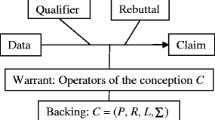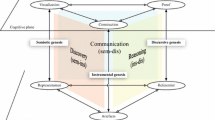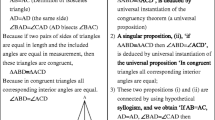Abstract
Proof and deductive method in mathematics have their origin in the classic model of exposition developed by Euclid in his famous book on Elements. The attitude of mathematicians towards this method has certainly evolved in the past centuries, but the relationship between understanding and acceptability of mathematical statements has not dramatically changed and still constitutes a characterising element of this discipline.
This paper is aimed at explaining and discussing some aspects which may be considered at the origin of difficulties related to proof, in particular, it focusses on the tension between two poles, that of production and that of systematisation of mathematical knowledge.
Some examples drawn from different research projects are presented with the aim of illustrating the complementarity of various aspects and problems concerning proof.
In the first part, the theoretical construct of Cognitive Unity is used to analyse and interpret the relationship between the production of a conjecture and its proof. In the second part, we present two long-term teaching experiments that are part of a research project whose principal goal is to introduce pupils to theoretical thinking and to study the role of particular microworlds in the teaching/learning processes. Assuming a vygotskian perspective, attention is focussed on the semiotic mediation accomplished through cultural artefacts; in the case of Geometry the microworld is Cabri-géomètr, in the case of algebra the microworld is the prototype “L’Algebrista” (designed and realized by our team).
Similar content being viewed by others
Bibliographie
Balacheff, N. (1987), Processus de preuve et situations de validation,Educational Studies in Mathematics, vol. 18, n. 2, pp. 147–76.
Balacheff, N. (1999), Pour un questionnement ethnomathématique de l’enseignement de la preuve, La lettre de la preuve, Sett./Oct. 1999,http://www-didactique.imag.fr/preuve
Balacheff N. (1998) Apprendre la preuve. In: J. Sallantin, Szczeciniarz J.-J. (eds.)La preuve à la lumière de l’intelligence artificielle. Paris: PUF
Bartolini Bussi M G. (1998, Verbal interaction in mathematics classroom: a Vygotskian analysis, Sierpinska, A. et al. (eds.)language and communication in mathematics classroom. NCTM, 65–84
Bartolini Bussi M. G., Boni, M., Ferri, F. & Garuti, R. (1999). Early Approach To Theoretical Thinking Gears in Primary School,Educational Studies in Mathematics, 39 (1–3), 67–87.
Baulac, Y., Bellemain, F. & Laborde, J.-M. (1988),Cabri-Géométre, un logiciel d’aide à l’enseignement de la gèomètrie, Logiciel et manuel d’utilisation, Version I.O. Macintosh de Apple. Paris: Nathan-logiciels.
Boero, P., Dapueto, C., Ferrari P., Ferrero, E., Garuti, R., Lemut, E., Parenti, L., Scali, E. (1995), Aspects of the Mathematics-Culture Relationship in Mathematics Teaching-Learning in Compulsory School,Proc. of PME-XIX, Recife
Boero P., Garuti R. & Mariotti, M.A. (1996), Some dynamic mental processes underlying producing and proving conjectures, inProceedings of the 20th PME Conference, Valencia
Cerulli M. & Mariotti, M.A. (2000), A symbolic manipulator to introduce pupils to algebra theory. Proceedings of Worksjop W6 “Learning Algebra with the Computer a Transdisciplinary Workshop”. ITS’2000, Montreal.
Cerulli, M. (1999)Uso di manipolatori simbolici nell’introduzione all’algebra: realizzazione e sperimentazione di un prototipo. Manuscript non publié, Tesi di Laurea in Matematica presso “Università degli Studi di Pisa”, Pisa.
Duval, R. (1991), Structure du raisonnement deductivf et apprentissage de la démostration.Educational Studies in Mathematics, 22, 233–261.
Duval, R., (1992–93), Argumenter, demontrer, expliquer: continuité ou rupture cognitive?, inPetti x, no 31, pp. 37–61.
Garuti R. & Boero, P. (1997) Cognitive Unity of theorems and difficulty of proof,
Garuti R., Boero P, Lemut E. & Mariotti, M.A. (1996), Challenging the traditional school approach to theorems: a hypothesis about the cognitive unity of theorems, inProceedings of the 20th PME Conference, Valencia.
Hanna, G. (1990), Some pedagogical aspects of proof,Interchange, 21, 6–13.
Harel, G. & Sowder, L. (1998), Students’ Proof schemes, Dubinsky E. et al.Collegiate Mathematics Education, Vol. III, A.M.S. 234–283.
Heath, T.: 1956 The Thirtheen Books of Euclid’s Elements, Dover, New York
Hilbert, D. (1971), Foundation of Geometry, Open Court Classic (Original title Grundlagen der Geometrie, first published 1899)
Lakatos, I. (1976)Proof and refutations, Cambridge university press
Lolli, G. (2000), ‘Truth and Proofs, a short course in the epistemology of mathematics’, in: Arzarello, F. & Ferrari, P.L. (eds):Proceedings of the School on Epistemology of Mathematics and Didactics, Levico Terme, 8–12 February 1999, (to appear)
Maracci M. (1988),Risoluzione di problem di geometria piana: l’aualisi dei processi in situazione sperimentale, Manuscript non publié, Tesi di Laurea in Matematica presso “Università degli Studi di Pisa”, Pisa
Mariotti, M. A. (1996), Costruzioni in geometria, suL’insegnamento della Matematica e delle Scienze Integrate, 19B, n.3, pp. 261–88
Mariotti, M.A. (1997), Justifying and proving: figural and conceptual aspects, in Hejny M. & Novotna J. (eds.)Proceedings of the European Research Conference on Mathematical Education, Podebrady, Czech Republic.
Mariotti M.A., Bartolini Bussi, M., Boero P., Ferri F., & Garuti R. (1997), Approaching geometry theorems in contexts: from history and epistemology to cognition,Proceedings of the 21th PME Conference, Lathi, pp. I-180-95.
Mariotti, M.A. & Bartolini Bussi M.G. (1998), From drawing to construction: teachers mediation within the Cabri environment, inProceedings of the 22nd PME Conference, Stellenbosh, pp. I-180-95.
Mariotti M. A. (2002) Influence of technologies advances on students’ math learning, in English L., Bartolini Bussi M.G., Jones G., Lesh R., & Tirosh D. (eds.)Handbook of International Research in Mathematics Education, Lawrence, Erbaum Associates.
Mogetta, C. (en cours de pubblication), “Informal and formal aspects of the proving process within a computer-based learning environment”,Proceedings of ICTMT 4 Plymouth.
Noss, R. & Hoyles, C. (1996)Windows on mathematical meanings, Dordrech: Kluwer Acc. Press
Thurston, W.P. (1994), On Proof and Progress in Mathematics,Bull. of the AMS, 30, 161–177.
Vygotskij L. S. (1978), Mind in Society. The Development of Higher Psychological Processes, Harvard University Press.
Author information
Authors and Affiliations
Rights and permissions
About this article
Cite this article
Mariotti, M.A. La preuve en mathématique. Zentralblatt für Didaktik der Mathematik 34, 132–145 (2002). https://doi.org/10.1007/BF02655807
Issue Date:
DOI: https://doi.org/10.1007/BF02655807




